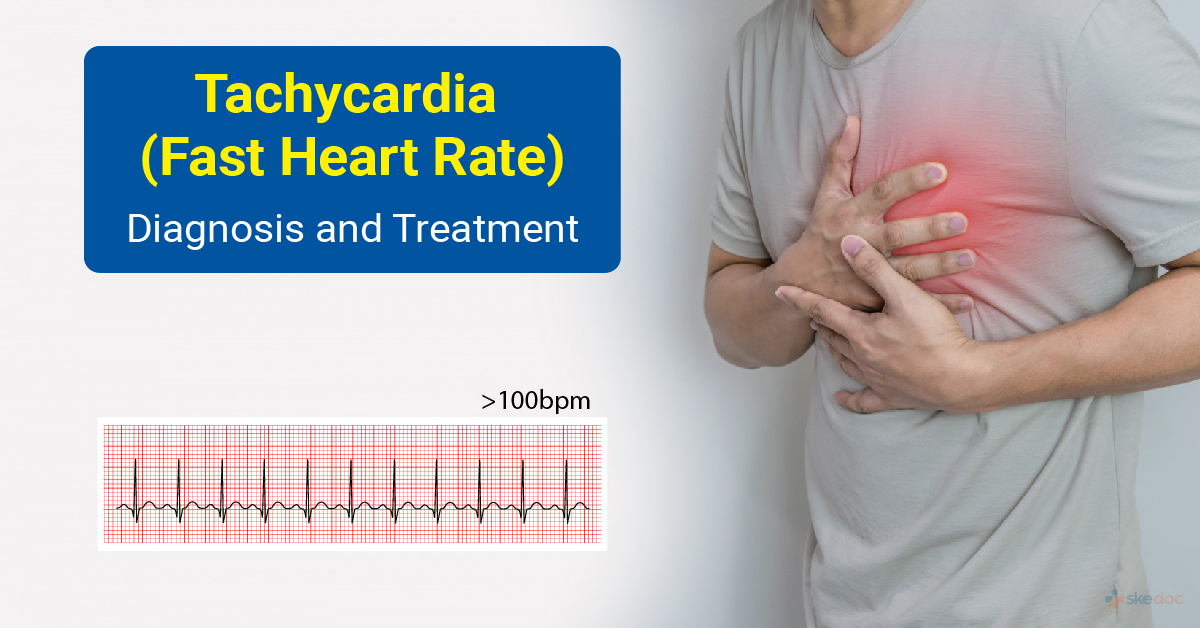Allergy
Blood Diseases
Bone & Joints
Brain
Cancer
Child Care
Cosmetic Surgery
Diabetes
Endocrinology
ENT
Eye
Gen Medicine
General Surgery
Heart
Kidney
Lifestyle
Liver & Digestive
Lung
Men’s Health
Mental health
Physiotherapy
Rheumatology
Skin and hair
Sleep Disorders
Spine
Transplant
Women Health
Thyroid
Vascular Surgery
Tachycardia

What is Tachycardia?
Tachycardia, also known as fast heart rate, is the presence of a resting heart rate of over 100 beats per minute or a fast heart rate over 100 BPM in the absence of physiological stress. Several medical conditions including non-cardiac conditions can result in a fast heart rate. This results in an inefficient functioning of the heart and consequently an inefficient supply of blood to the rest of the body.
Alternate names
- Tachyarrhythmia
Is this condition a medical emergency?
Tachycardia can become a medical emergency, and it is advisable to seek early medical attention.
Types
Tachycardia can be classified as follows:
- Narrow complex Tachycardias or wide complex Tachycardias based on the width of the QRS complex on an ECG
- Tachycardias may also be classified as regular or irregular
Based on the origin of the abnormal electrical impulse, tachycardia may also be of the following types:
- Supraventricular Tachycardia: The abnormal impulse generation happens above the level of the ventricles.
- Atrial Fibrillation: Rapid heart rate that is irregular and originating in the upper chambers (atria).
- Atrial Flutter: Rapid but regular heart rate and originating in the atria.
- AV nodal Re-entrant Tachycardia: There is a re-entry of the electrical impulse causing additional stimulation of the upper and lower chambers of the heart; it is a narrow complex tachycardia
- AV Re-entrant Tachycardia: It is a reentrant tachycardia in which an additional pathway for the conduction of the electrical impulses is present; it is a narrow complex tachycardia
- Junctional Tachycardia: The abnormal electrical impulses originate in the atrioventricular junction
- Ventricular Tachycardia: Regular and rapid heart rate that is potentially life-threatening and originating in the ventricles; it is a wide complex Tachycardia with an improper filling of the lower chambers of the heart.
- Ventricular Fibrillation: It is a rapid irregular heart rate that is life-threatening; the lower chambers are no longer contracting but are in a quivering state.
Causes
The electrical system of the heart controls the muscles in the upper two and the lower two chambers of the heart and maintains a perfect rhythm and synchronicity in their contraction and relaxation enabling the heart to fill with blood and pump the blood to the rest of the body. Two nodes are responsible for the generation and conduction of the impulses; the sinus node from which electrical impulses originate for each heartbeat starting in the upper chambers and the AV node which carries the signals to the lower chambers.
Several conditions can disrupt the flow of the electrical signals in the heart’s electrical pathway. Some common conditions that result in fast heart rate include:
- Anemia
- Anxiety and fear
- Circulatory shock
- Hyperthyroidism
- Low circulatory volume/dehydration
- Hypoglycemia (low blood sugar)
- Lack of sleep
- Fever
- Electrolyte imbalance
- Recreational drugs
- Medications
- Excessive alcohol consumption
- Smoking
- Severe stress
Risk factors
Factors that increase the risk of Tachycardia include:
- Heart disease
- Anemia
- Diabetes
- Hypertension
- Alcohol abuse
- Heavy caffeine intake
- Psychological stress
- Smoking
- Use of recreational drugs like cocaine
Symptoms & signs
Tachycardia may sometimes be asymptomatic and only discovered during medical examinations for other conditions. The signs and symptoms when present may include:
- Rapid pulse rate
- Palpitations
- Dizziness
- Shortness of breath
- Chest pain
- Fainting
Investigations
Some investigations that are advised for the evaluation of tachycardia include:
- Laboratory tests:
- CBP & ESR
- Thyroid Profile
- Iron profile
- Blood sugar levels
- Complete metabolic panel
- ECG: Additionally with Holter monitoring or event monitoring if required
- Imaging tests:
- Chest X-ray
- Echocardiogram
- Coronary Angiogram
- CT/MRI Scan
- Stress testing
- Tilt table testing
Diagnosis
A diagnosis of tachycardia and the underlying cause is established based on medical history, clinical evaluation, and results of the investigations done.
Treatment options
The treatment of tachycardia aims to bring the heart rate back to normal, prevent complications and future episodes, and managing the underlying cause responsible.
Medical management
Medical management of tachycardia may include the following:
- Antiarrhythmic agents
- Beta-Blockers
- Correction of electrolyte imbalance
- Anticoagulants
Interventional including surgery and indications for surgery
Interventions for the management of fast heart rate may include:
- Cardioversion and defibrillation: Done with the help of external shock delivered to the heart to restore the normal heart rate.
- Catheter ablation: The abnormal source of electrical impulses is identified and destroyed using radiofrequency energy.
- Pacemaker implantation: A small battery-operated device is placed under the skin in the chest to control the flow of electrical impulses within the heart and maintain a normal heart rate.
- Implantable cardioverter-defibrillator: If there is a risk of future episodes of life-threatening tachycardias developing, a small battery-operated device is placed under the skin and connected to the heart to deliver shocks if an abnormal rhythm develops.
- Open heart surgery: May be required in a few cases of Tachycardia to destroy the abnormal electrical pathways and restore normal heart rate.
Role of Diet/ Exercise/ Lifestyle changes/ Preventive measures
Some measures that can be taken to prevent and manage fast heart rate include:
- Vagal Maneuver: Done by coughing and bearing down as done when having a bowel movement, and placing an ice pack on the face.
- Eating a healthy diet, and maintaining an ideal body weight
- Keeping diabetes and hypertension under control
- Exercising regularly and avoiding a sedentary lifestyle
- Cessation of smoking
- Cessation or moderation of alcohol consumption
- Avoiding recreational drugs
- Limiting the intake of caffeine and caffeinated drinks
- Reducing stress
Complications
Some complications that are associated with tachycardia include:
- Increased risk of thromboembolism due to blood clots
- Increased risk of stroke
- Increased risk of heart failure
- Increased risk of myocardial infarction
- Death
Prognosis
The prognosis for tachycardia depends on the type of tachycardia, the underlying cause, and the general health of the individual. Some tachycardia such as ventricular tachycardia tends to progress to complications very fast and can be life-threatening, while others may not show any symptoms and persist for a long time without causing any adverse effects.
When to contact the doctor or hospital? / How to identify the emergency or complications?
It is advisable to seek medical attention if the signs and symptoms of a fast heart rate are noticed.
Indications for hospitalization if required
Hospitalization may be required for the management of certain types of tachycardia.
Suggested clinical specialist/ Department to consult for this condition
- Cardiology
Was this article helpful?
YesNo




